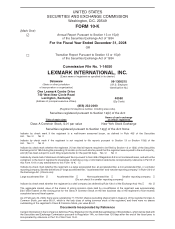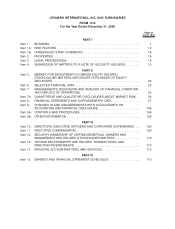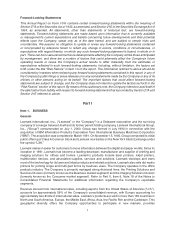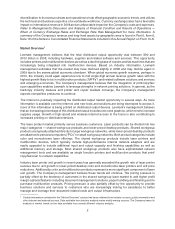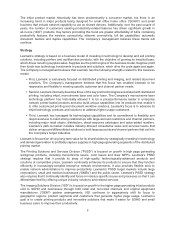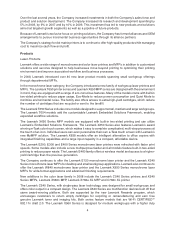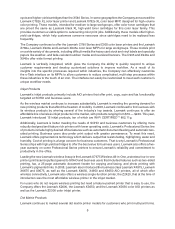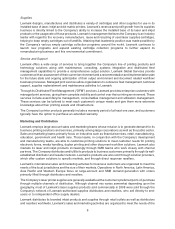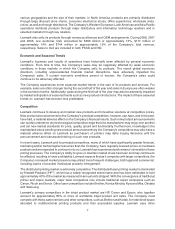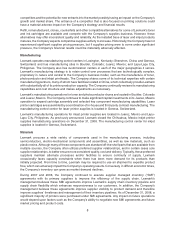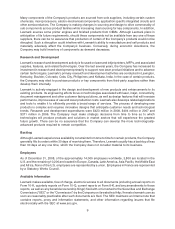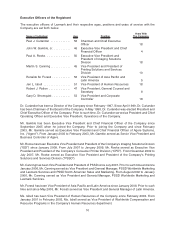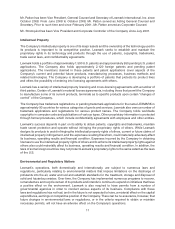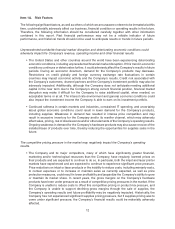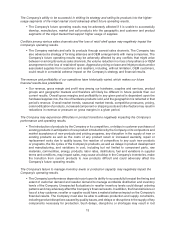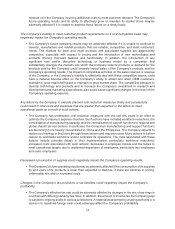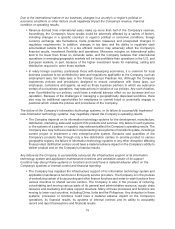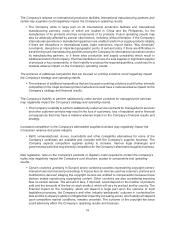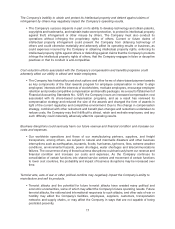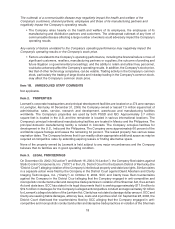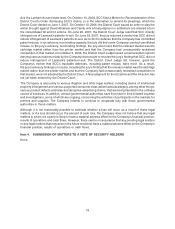Lexmark 2008 Annual Report Download - page 15
Download and view the complete annual report
Please find page 15 of the 2008 Lexmark annual report below. You can navigate through the pages in the report by either clicking on the pages listed below, or by using the keyword search tool below to find specific information within the annual report.Many components of the Company’s products are sourced from sole suppliers, including certain custom
chemicals, microprocessors, electro-mechanical components, application specific integrated circuits and
other semiconductors. The Company is making changes in sourcing and design to drive commonality of
sub components across product families while increasing dual sourcing for key components. In addition,
Lexmark sources some printer engines and finished products from OEMs. Although Lexmark plans in
anticipation of its future requirements, should these components not be available from any one of these
suppliers, there can be no assurance that production of certain of the Company’s products would not be
disrupted. Such a disruption could interfere with Lexmark’s ability to manufacture and sell products and
materially adversely affect the Company’s business. Conversely, during economic slowdowns, the
Company may build inventory of components as demand decreases.
Research and Development
Lexmark’s research and development activity is focused on laser and inkjet printers, MFPs, and associated
supplies, features, and related technologies. Over the last several years, the Company has increased its
investment in research and development primarily to support new laser product initiatives and to advance
certain technologies. Lexmark’s primary research and development activities are conducted in Lexington,
Kentucky; Boulder, Colorado; Cebu City, Philippines; and Kolkata, India. In the case of certain products,
the Company may elect to purchase products or key components from third-party suppliers rather than
develop them internally.
Lexmark is actively engaged in the design and development of new products and enhancements to its
existing products. Its engineering efforts focus on technologies associated with laser, inkjet, connectivity,
document management and other customer facing solutions, as well as design features that will increase
performance, improve ease of use and lower production costs. Lexmark also develops related applications
and tools to enable it to efficiently provide a broad range of services. The process of developing new
products is complex and requires innovative designs that anticipate customer needs and technological
trends. Research and development expenditures were $423 million in 2008, $404 million in 2007 and
$371 million in 2006. The Company must make strategic decisions from time to time as to which
technologies will produce products and solutions in market sectors that will experience the greatest
future growth. There can be no assurance that the Company can develop the more technologically-
advanced products required to remain competitive.
Backlog
Although Lexmark experiences availability constraints from time to time for certain products, the Company
generally fills its orders within 30 days of receiving them. Therefore, Lexmark usually has a backlog of less
than 30 days at any one time, which the Company does not consider material to its business.
Employees
As of December 31, 2008, of the approximately 14,000 employees worldwide, 3,800 are located in the
U.S. and the remaining 10,200 are located in Europe, Canada, Latin America, Asia Pacific, the Middle East
and Africa. None of the U.S. employees are represented by a union. Employees in France are represented
by a Statutory Works Council.
Available Information
Lexmark makes available, free of charge, electronic access to all documents (including annual reports on
Form 10-K, quarterly reports on Form 10-Q, current reports on Form 8-K, and any amendments to those
reports, as well as any beneficial ownership filings) filed with or furnished to the Securities and Exchange
Commission (“SEC” or the “Commission”) by the Company on its website at http://investor.lexmark.com as
soon as reasonably practicable after such documents are filed. The SEC maintains an Internet site that
contains reports, proxy and information statements, and other information regarding issuers that file
electronically with the SEC at www.sec.gov.
9


